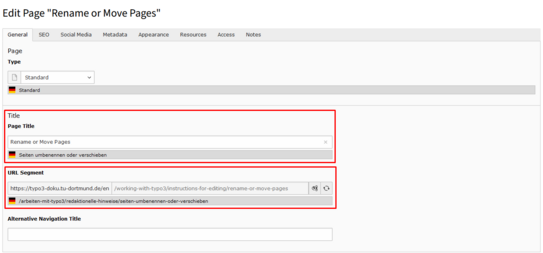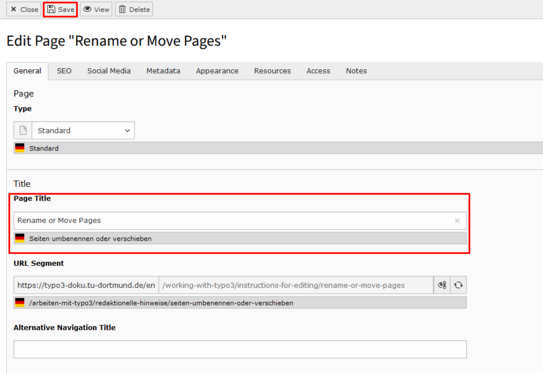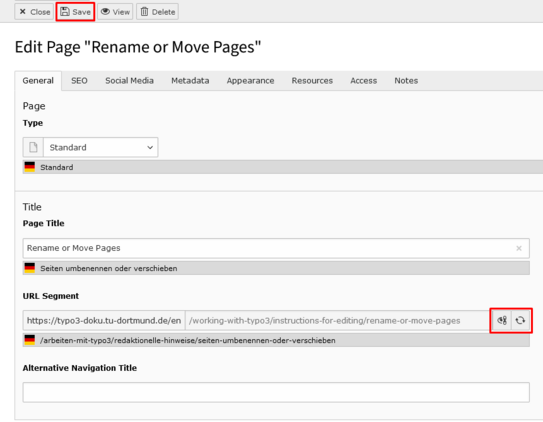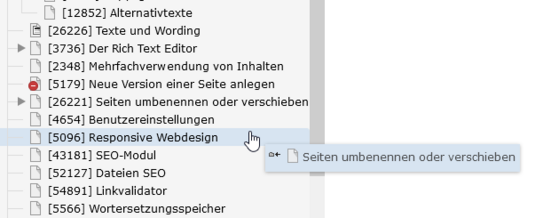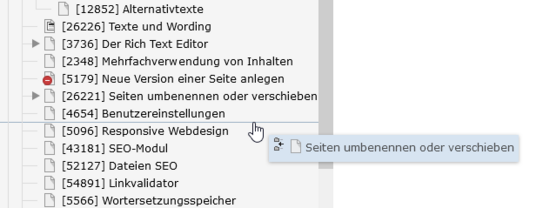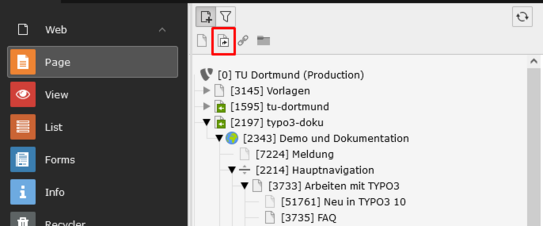Rename or Move Pages
This topic page explains what you need to pay attention to when renaming and moving pages.
Pages in TYPO3 have a page title and a URL segment. The page title is the name of the page, which you see in the page tree of the backend and which is also visible in the menus of the frontend by default. The URL segment is the address under which the page can be reached in the frontend.
In the TYPO3 backend, you can access both elements by opening the page properties of a page and switching to the "General" tab (see screenshot "Page Properties").
Important: Once pages have been published, the URL segment should - if possible - no longer be adjusted. Visitors, external websites and also search engines that call up the old URL segment receive a 404 error because the page can no longer be found under the old URL segment. This has a negative effect on search engine rankings.
Rename Pages
If you need to rename a page, please follow these instructions:
1. The URL Segment Should Not Be Updated
If possible, change only the page title of a page and do not update the URL segment. In this case, the URL segment and page title differ, but the page is still accessible under the old URL segment. This way you can prevent the problems described above and no further steps are necessary.
To do this, open the page properties of the respective page. In the "General" tab, enter the new page title in the "Page title" input field. Afterwards you can "Save" the changes and close the page properties (see screenshot "Change Page Title").
2. If it is Necessary to Update the URL Segment
If the URL segment must be the same as the new page title, you can adjust it as follows (but be aware of the possible consequences, which are indicated in the info box at the top of the page):
In the first step, change the page title as described before, but do not save the changes yet.
The second step is to customize the URL segment. By clicking on the two icons to the right of the "URL segment" field, you have two options to proceed (see screenshot "URL segment customization"):
- Generate URL segment from the page title: If you click the icon with the two arrows, the URL segment is automatically regenerated from the page title. This should be the preferred approach.
- Assign your own URL segment: If you click on the icon with the eye and the chain, you can assign the URL segment yourself.
Then save the changes.
Note: If the page has high traffic, you can create a short link that corresponds to the old URL segment and points to the new URL segment. This way, visitors, external websites, and search engines that still access the old URL segment will be redirected to the new URL segment.
Move Pages
Consider before moving a published page: Usually, the URL segment must be adjusted. This causes the problems described in the infobox at the top of the page. Visitors to your site will also have to get used to a different click path to access the page.
To move a page in the page tree, move the mouse over the page in question and hold down the left mouse button. With the left mouse button held down, you now move the page to its new position in the page tree.
If you drag the page directly to an already existing page in the page tree and then release the left mouse button, the moved page will be created as a subpage (see screenshot "Move Page onto Existing Page").
If you drag the page between two already existing pages of the page tree and then release the left mouse button, the moved page will be placed between these two pages - on the same navigation level (see the "Move Page Between Two Existing Pages" screenshot).
After you have moved the page, update the URL segment. Proceed as described in "Rename pages".
Then create a new page of type "Link" at the old position of the page in the page tree (see screenshot "Create Reference"). The link must have the URL segment of the moved page and point to it. Accesses to the old URL segment do not fail as a result. Visitors can also reach the content via the old click path in the navigation.





